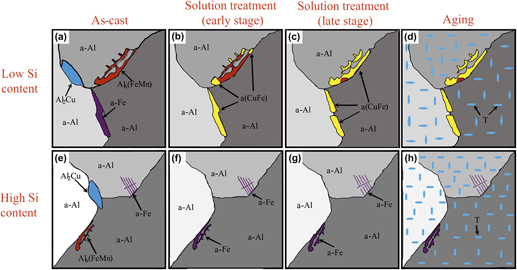Crossref Citations
This article has been cited by the following publications. This list is generated based on data provided by
Crossref.
Zhao, Yuliang
Lin, Bo
Song, Dongfu
Zheng, Donghai
Sun, Zhenzhong
Xie, Chunxiao
and
Zhang, Weiwen
2019.
Effect of Compound Fields of Ultrasonic Vibration and Applied Pressure on the 3D Microstructure and Tensile Properties of Recycled Al-Cu-Mn-Fe-Si Alloys.
Materials,
Vol. 12,
Issue. 23,
p.
3904.
Lin, Bo
Xu, Rui
Li, Haoyu
Shi, Ya
Xiao, Huaqiang
and
Zhang, Weiwen
2019.
Developing high performance squeeze cast Al-Cu alloys with high Fe and Cu contents.
International Journal of Cast Metals Research,
Vol. 32,
Issue. 2,
p.
106.
Zhao, Yuliang
Wang, Zhi
Zhang, Chun
and
Zhang, Weiwen
2019.
Synchrotron X-ray tomography investigation of 3D morphologies of intermetallic phases and pores and their effect on the mechanical properties of cast Al-Cu alloys.
Journal of Alloys and Compounds,
Vol. 777,
Issue. ,
p.
1054.
Park, Cheon Myeong
Jung, JeKi
Yu, Byung Chul
and
Park, Yong Ho
2019.
Anisotropy of the Wear and Mechanical Properties of Extruded Aluminum Alloy Rods (AA2024-T4).
Metals and Materials International,
Vol. 25,
Issue. 1,
p.
71.
Zhao, Yuliang
Song, Dongfu
Lin, Bo
Zhang, Chun
Zheng, Donghai
Inguva, Saikumar
Li, Tao
Sun, Zhenzhong
Wang, Zhi
and
Zhang, Weiwen
2019.
3D characterization of ultrasonic melt processing on the microstructural refinement of Al Cu alloys using synchrotron X-ray tomography.
Materials Characterization,
Vol. 153,
Issue. ,
p.
354.
Bolibruchová, Dana
Matejka, Marek
Michalcová, Alena
and
Kasińska, Justyna
2020.
Study of Natural and Artificial Aging on AlSi9Cu3 Alloy at Different Ratios of Returnable Material in the Batch.
Materials,
Vol. 13,
Issue. 20,
p.
4538.
Xu, Zhen
Zhang, Xinyu
Wang, Hongbin
Gao, Anni
Ma, Tingyue
and
Song, Hua
2020.
Effect of Mn/Fe ratio on the microstructure and properties of 6061 sheets obtained by twin-roll cast.
Materials Characterization,
Vol. 168,
Issue. ,
p.
110536.
Zhao, Yuliang
Song, Dongfu
Wang, Haoliang
Jia, Yiwang
Lin, Bo
Tang, Yue
Tang, Ying
Shu, Da
Sun, Zhenzhong
Fu, Yanan
and
Zhang, Weiwen
2021.
Revealing the Influence of Fe on Fe-Rich Phases Formation and Mechanical Properties of Cast Al-Mg-Mn-Fe Alloys.
SSRN Electronic Journal ,
Ganjehfard, Khalil
Taghiabadi, Reza
Noghani, Mohammad Talafi
and
Ghoncheh, Mohammad Hossein
2021.
Tensile properties and hot tearing susceptibility of cast Al-Cu alloys containing excess Fe and Si.
International Journal of Minerals, Metallurgy and Materials,
Vol. 28,
Issue. 4,
p.
718.
Zhao, Yuliang
Song, Dongfu
WANG, HAOLIANG
Chen, Lijia
Sun, Zhenzhong
Zhai, Tongguang
Fu, Yanan
Wang, Yao
Liu, Shuhong
Du, Yong
and
Zhang, Weiwen
2021.
Revealing the Nucleation and Growth Mechanisms of Fe-Rich Phases in Al-Cu-Fe(-Si) Alloys Under the Influence of Al-Ti-B.
SSRN Electronic Journal ,
Pańcikiewicz, Krzysztof
2021.
Preliminary Process and Microstructure Examination of Flux-Cored Wire Arc Additive Manufactured 18Ni-12Co-4Mo-Ti Maraging Steel.
Materials,
Vol. 14,
Issue. 21,
p.
6725.
Zhao, Yuliang
Zhang, Weiwen
Song, Dongfu
Lin, Bo
Shen, Fanghua
Zheng, Donghai
Xie, ChunXiao
Sun, Zhenzhong
Fu, Yanan
and
Li, Runxia
2021.
Nucleation and growth of Fe-rich phases in Al-5Ti-1B modified Al-Fe alloys investigated using synchrotron X-ray imaging and electron microscopy.
Journal of Materials Science & Technology,
Vol. 80,
Issue. ,
p.
84.
Zhao, Yuliang
He, Weixiang
Song, Dongfu
Shen, Fanghua
Li, Xinxin
Sun, Zhenzhong
Wang, Yao
Liu, Shuhong
Du, Yong
and
Fernández, Ricardo
2022.
Effect of ultrasonic melt processing and Al-Ti-B on the microstructural refinement of recycled Al alloys.
Ultrasonics Sonochemistry,
Vol. 89,
Issue. ,
p.
106139.
Zhao, Yuliang
Song, Dongfu
Wang, Haoliang
Jia, Yiwang
Lin, Bo
Tang, Yue
Tang, Ying
Shu, Da
Sun, Zhenzhong
Fu, Yanan
and
Zhang, Weiwen
2022.
Revealing the influence of Fe on Fe-rich phases formation and mechanical properties of cast Al-Mg-Mn-Fe alloys.
Journal of Alloys and Compounds,
Vol. 901,
Issue. ,
p.
163666.
Guo, Hongmin
Hu, Wenjie
Yang, Kunyi
and
Yu, Cisheng
2022.
Effects of Si and Fe additions on mechanical properties of as-cast Al–5Cu alloys.
Materials Science and Technology,
Vol. 38,
Issue. 6,
p.
352.
Liu, Fei
Zhao, Haidong
Chen, Bo
and
Zheng, Huiting
2022.
Investigation on microstructure heterogeneity of the HPDC AlSiMgMnCu alloy through 3D electron microscopy.
Materials & Design,
Vol. 218,
Issue. ,
p.
110679.
Lin, Bo
he, xiangxiang
Zhao, Yuliang
Xu, Rui
and
Lu, Yemao
2022.
Evolution of Iron-Rich Intermetallics and its Effect on the Mechanical Properties of Al-Cu-Mn-Fe-Si Alloys after Thermal Exposure and High-Temperature Tensile Testing.
SSRN Electronic Journal ,
Zhao, Yuliang
Song, Dongfu
Wang, Haoliang
Li, Xinxin
Chen, Lijia
Sun, Zhenzhong
Wang, Zhi
Zhai, Tongguang
Fu, Yanan
Wang, Yao
Liu, Shuhong
Du, Yong
and
Zhang, Weiwen
2022.
Revealing the nucleation and growth mechanisms of Fe-rich phases in Al–Cu–Fe(-Si) alloys under the influence of Al–Ti–B.
Intermetallics,
Vol. 146,
Issue. ,
p.
107584.
Rodrigues, Adilson Vitor
Kakitani, Rafael
Silva, Cássio
Giovanetti, Leonardo
Dias, Marcelino
Henein, Hani
Garcia, Amauri
and
Cheung, Noé
2023.
Influence of Minor Additions of Be on the Eutectic Modification of an Al-33wt.%Cu Alloy Solidified under Transient Conditions.
Metals,
Vol. 13,
Issue. 1,
p.
94.
Arriaga-Benitez, Raul I.
and
Pekguleryuz, Mihriban
2023.
The synergistic effects of nano-sized α-Al(Mn,Cr,Fe)Si and Al–Si–Zr dispersoids on the creep behavior Al–Si–Mg–Cu (Mn, Cr, Zr) diesel engine alloy.
Materials Science and Engineering: A,
Vol. 872,
Issue. ,
p.
144949.



